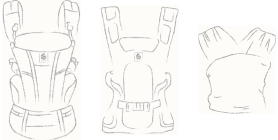Claire Kellerman
“I want my baby to thrive.” Can it be as simple and easy as nature intends? Not every doctor integrates nature’s wisdom in their standard recommendations, so this book can be your supportive guide. Your choices and decisions are restored to their rightful, healthiest place in honoring yourself, your intuition, and your baby’s true needs. This is crucial for giving your family and your baby its best first steps towards thriving. What Your Pediatrician Doesn’t Know Can Hurt Your Child; A More Natural Approach to Parenting takes an in-depth look at the choices that are sometimes missing, as they have been removed in the sterile procedures and interferences of history, habit and some hospitals. Knowing what these choices are and the reasons behind them makes your decisions as a parent more optimally grounded in confidence and facts. Author Pediatrician Dr. Susan Markel points out that too often babies and parents are subject to the opinions of authorities, pseudo-science, and trends
 “As long as I wear him, he’s content,” Martha Sears, R.N., mentioned to her husband, Dr. William Sears, as they discovered babywearing with their sixth child. It is an affirmation of how life works well naturally. The healthiest choice feels good, and feels right, because it supports survival as well as thriving. Babies reflect this in how they are often calmly alert, or quieted, and relaxed into sleeping easily by the simple practice of babywearing. It is the place a baby wants to be; heart-to-heart, skin-to-skin, breath-to-breath and face-to-face; sharing in life’s activities from a soothing place of familiar rhythm, near a comforting heartbeat and easily accessed breast milk. A baby likes the closeness, the movement, and the loving touches from hands that are free, free…free. Babywearing is a win/win/win choice.
Dr. Sears shares his observations after years of advocating babywearing with his patients: Babies who are worn thrive, are calmer, smarter, make daycare easier, and allow
“As long as I wear him, he’s content,” Martha Sears, R.N., mentioned to her husband, Dr. William Sears, as they discovered babywearing with their sixth child. It is an affirmation of how life works well naturally. The healthiest choice feels good, and feels right, because it supports survival as well as thriving. Babies reflect this in how they are often calmly alert, or quieted, and relaxed into sleeping easily by the simple practice of babywearing. It is the place a baby wants to be; heart-to-heart, skin-to-skin, breath-to-breath and face-to-face; sharing in life’s activities from a soothing place of familiar rhythm, near a comforting heartbeat and easily accessed breast milk. A baby likes the closeness, the movement, and the loving touches from hands that are free, free…free. Babywearing is a win/win/win choice.
Dr. Sears shares his observations after years of advocating babywearing with his patients: Babies who are worn thrive, are calmer, smarter, make daycare easier, and allow The No-Cry Sleep Solution Gentle Ways to Help Your Baby Sleep Through the Night By Elizabeth Pantley For those many parents who first tested Elizabeth Pantley’s “No-Cry Sleep Solution,” thank you for your combined patience and persistence proving the efficacy of this system with your own babies. I imagine some parents first picked up this book in a hazy state of mind-altering sleep deprivation, read the title through half-shut eyes, and muttered, ‘My baby? Sleep through the night? Are you kidding?’ The No-Cry Sleep Solution: Gentle Ways to Help Your Baby Sleep Through the Night delivers: there is a ten-step plan you can follow, borne of “dissecting truth from fallacy.” There are insights into the mutual agony for parents and child with the cry-it-out method. You will know you are not alone on this journey as you read parent testimonials and their email updates on their progress, such as, “It was one step forward, two steps back for a while, and now she is sleeping soundly consistently
Author Betsy Miller was successfully treated for hip dysplasia as an infant, and was able to walk, run, jump and play in her youth. As an adult, she experienced an unusual problem with her hips that lead her to search for answers that were not readily available except in medical journals. Being a professional technical writer, she was inclined to seize the subject and dive into research to find her own answers. She shares the depth and details of what she found, the most helpful and clear information, to allow parents to care for their children with hip issues with less confusion and more confidence. In The Parents’ Guide to Hip Dysplasia, Betsy Miller combines her experience and interest in hip dysplasia with her skills as a technical writer to bring parents answers to their questions about DDH and CDH. This 118-page book is written in simple every-day language and includes the practical and medical facts of developmental dysplasia of the hip, and congenital dysplasia of the hip. Any
“Most of the present world cultures practice forms of cosleeping and there are very few cultures in the world for which it would ever even be thought acceptable or desirable to have babies sleep alone.” Dr. James J. McKenna’s book, Sleeping with Your Baby: A Parent’s Guide to Cosleeping brings light to the facts behind outdated cultural opinions and practices that have interfered with the most natural and supportive ways of parenting and co-sleeping. With passion for his subject, Dr. McKenna includes guidance on how to support babies getting optimal sleep, nourishment during the night, and how best to respond to little ones who are crying. Letting babies “cry it out” is not the way, according to decades of research and eons of experience throughout human evolution. Our nature is to snuggle, as our biology confirms. Snuggle, don’t struggle. “All mammals cosleep in one form or another.” “The low calorie composition of human breast milk (exquisitely adjusted for the human
Vimala McClure was a young woman in her early 20’s when she went to India and cared for babies in a large children’s home. Despite the very rustic living situation, and the limited amount of food for the babies, they seemed to thrive. She wondered why, until the evening she saw the older girls massaging the babies before putting them to bed. “The babies loved it,” Vimala said, “and they went right to sleep afterwards.” So when Vimala returned to the US, and had babies of her own, she chose to massage them, and in the process brought infant massage to the West. The massage Vimala designed, in those deep moments listening to her own babies, combined together the Indian infant massage techniques she had learned at the children’s home, with Swedish massage, reflexology and yoga. She collected information about babies’ amazing response to touch, and wrote her classic book, Infant Massage: A Handbook for Loving Parents. That book started a movement. The massage she developed, responding to her
La Leche League’s “Big Latch On” event, August 6th, 2011 “Women were ready to take charge of their own bodies. There was a need.” This was her answer when one founder was asked why they started La Leche League International (LLLI). In 1956, seven women founded La Leche League International united by a common bond: their mutual appreciation for natural birth and their healthy, happy breastfeeding babies. They nurtured, nursed and practiced what they preached, with a combined total of 63 children, 161 grandchildren, and 30 great grandchildren, as of 2008. They were encouraged by enthusiastic husbands, and inspired by their enjoyment to share what they knew with other mothers, in their Elmhurst, Illinois vicinity, who were often asking for guidance on how best to breastfeed their babies. In the words of each of the seven founders, here are some of their thoughts and history from their journey together. Their detailed chronological history as an organization, photos, and wonder-filled
There is a deeply caring quality reflected in Ina May Gaskin’s life as a certified professional midwife for over 35 years, as an author, educator, community member, and the mother of three home-birthed children. She brings her life’s work and experience to the 340 pages of this rich resource on breastfeeding. Like her book, Spiritual Midwifery, Ina May’s Guide to Breastfeeding is destined to be a classic. Word is bound to spread quickly to every mother interested in “everything you need to know to make breastfeeding a joyful, natural, and richly fulfilling experience for both you and your baby.” The contents of this book bring insights into the personal journey of becoming a family, from how your birth choices determine the quality of your breastfeeding experience, to the advantages of delaying cutting the umbilical cord. There are lists of Baby-Friendly hospitals, herbs to avoid, and how to handle sick and hospitalized babies, and colds, diarrhea, or reflux. The mystery and
The five subthemes are : Globalisation, Listening to Women and their Partners, The Continuum of Care, Strengthening Midwives and Midwifery Practice, and Culture, Society and Traditions. Globalization This sub-theme covers opportunities for midwives from all over the world to support and encourage one another through collaboration and the sharing of experiences, both similar and different. This sub-theme will highlight human resource issues and migration of midwives, developing sustainable women and child health care programmes particularly in middle and low income settings, and explore the impact of HIV/AIDS on midwifery services. Listening to women and their partners This sub-theme focuses on the voices of women and their partners in reproductive health and learning from these perspectives and expectations. It includes issues of communication, emotional support and the role of support/network groups in maternity care. It also incorporates the critical issue of human rights
Pregnant friends, couples and mothers all light up at the mention of what has become the classic book on home birth. It is refreshingly real and thorough in every respect, from touching and graphic birth stories to medical wisdom with drawings, illustrations, and photos to make the information readily useful and usable for all parents. This book is a journey down a comforting, well-worn path that illuminates the sacredness of birth and how each new baby’s birth offers a blessing and a Spiritual experience for everyone involved. Ina May Gaskin reflects, “It is difficult for any human to express compassion who has not been on the receiving end of it. Being compassionate to the pregnant or birthing mother is not just an insignificant nicety of our practice – it lies at the very heart of our success. Kindness begets kindness that is passed on to nursing babies and to proud fathers, to brothers and sisters, cousins, aunts and uncles.” The first section details the personal stories of parents





















